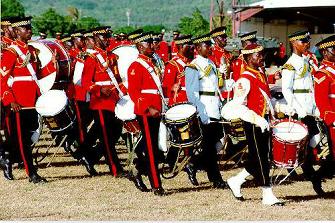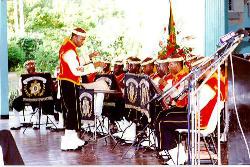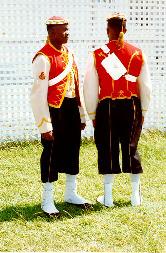|
Music The Role of Music
There are 2 bands in the JDF which play at State occasions and military events. Musicians also take on an operational role, usually as Medical Assistants. Introduction
These bands of the JDF are in every sense versatile, as their members are not only musicians but soldiers as well. The Jamaica Military Band
By 1799 there were twelve single-battalion West India Regiments, some of which were involved in the fierce West Indies actions of the Napoleonic Wars, and a few in the later Ashanti Wars in West Africa. From early in the 19th century they had been reduced in number until by 1888 there was but a single regiment. In 1892, a Jamaican, Lance Corporal (later Sergeant) William James Gordon of the West India Regiment received Britain’s highest, and very rarely awarded gallantry decoration, the Victoria Cross.
The transformation into the Jamaica Military Band is in itself noteworthy. As the Band of the WIR, it gave its final performance at a reception at Trafalgar House in Kingston in early 1927, before Their Royal Highnesses the Duke and Duchess of York (later King George VI and Queen Elizabeth, the present Queen Mother). The bandsmen turned in their instruments after the performance, but fortunately sentiment prevailed and the band was revived on 27th February 1927 as the Jamaica Military Band. This band has performed in various Caribbean countries including Cuba and St Christopher & Nevis; several cities in the United States including New York, Chicago, Atlanta and Miami; and a number of cities in the United Kingdom, as well as at Britain’s famed Aldershop Military Display. The Jamaica Military Band has performed in every military tattoo in Jamaica since 1933. |
 There are two military bands in the JDF – the
Jamaica Military Band (JMB) and the Jamaica Regiment Band (JRB). Their
musicians represent much of the public face of the Jamaica Defence Force –
not only in Jamaica, but in the wider Caribbean and beyond; they represent
also the rich traditions associated with our country’s military history.
Their musicianship – together with their precision and bearing and the splendour of their uniforms –
captures the pride and glory of the JDF.
There are two military bands in the JDF – the
Jamaica Military Band (JMB) and the Jamaica Regiment Band (JRB). Their
musicians represent much of the public face of the Jamaica Defence Force –
not only in Jamaica, but in the wider Caribbean and beyond; they represent
also the rich traditions associated with our country’s military history.
Their musicianship – together with their precision and bearing and the splendour of their uniforms –
captures the pride and glory of the JDF.  The Jamaica Military Band has direct descent
from the first of the old West India Regiments, which was formed in 1795 in
the Windward Islands of the Eastern Caribbean. One of two units drafted into
this regiment was the Black Carolina Corps, the remnant of a British
loyalist regiment in the aftermath of the American War of Independence.
The Jamaica Military Band has direct descent
from the first of the old West India Regiments, which was formed in 1795 in
the Windward Islands of the Eastern Caribbean. One of two units drafted into
this regiment was the Black Carolina Corps, the remnant of a British
loyalist regiment in the aftermath of the American War of Independence.  Through much of the 19th century,
what is now the Jamaica Military Band was the band of the original and last
surviving regiment,
and thus came by its almost unique ‘Zouave’ uniform (the only other unit in
the world which wears it is the Band of the Barbados Regiment). This was
first issued in 1858. It is said that at a review of French colonial troops,
Queen Victoria had been impressed by the uniform of the Zouaves (light
infantry of North African origin), and afterwards instructed that it be
introduced into a regiment of her army. An adaptation of this uniform,
unlike any other in the British Army before or since, became the full-dress
uniform of the West India Regiments until the last of them was disbanded in
1926 for reasons of economy. It has been worn ever since by the members of
the Band.
Through much of the 19th century,
what is now the Jamaica Military Band was the band of the original and last
surviving regiment,
and thus came by its almost unique ‘Zouave’ uniform (the only other unit in
the world which wears it is the Band of the Barbados Regiment). This was
first issued in 1858. It is said that at a review of French colonial troops,
Queen Victoria had been impressed by the uniform of the Zouaves (light
infantry of North African origin), and afterwards instructed that it be
introduced into a regiment of her army. An adaptation of this uniform,
unlike any other in the British Army before or since, became the full-dress
uniform of the West India Regiments until the last of them was disbanded in
1926 for reasons of economy. It has been worn ever since by the members of
the Band.